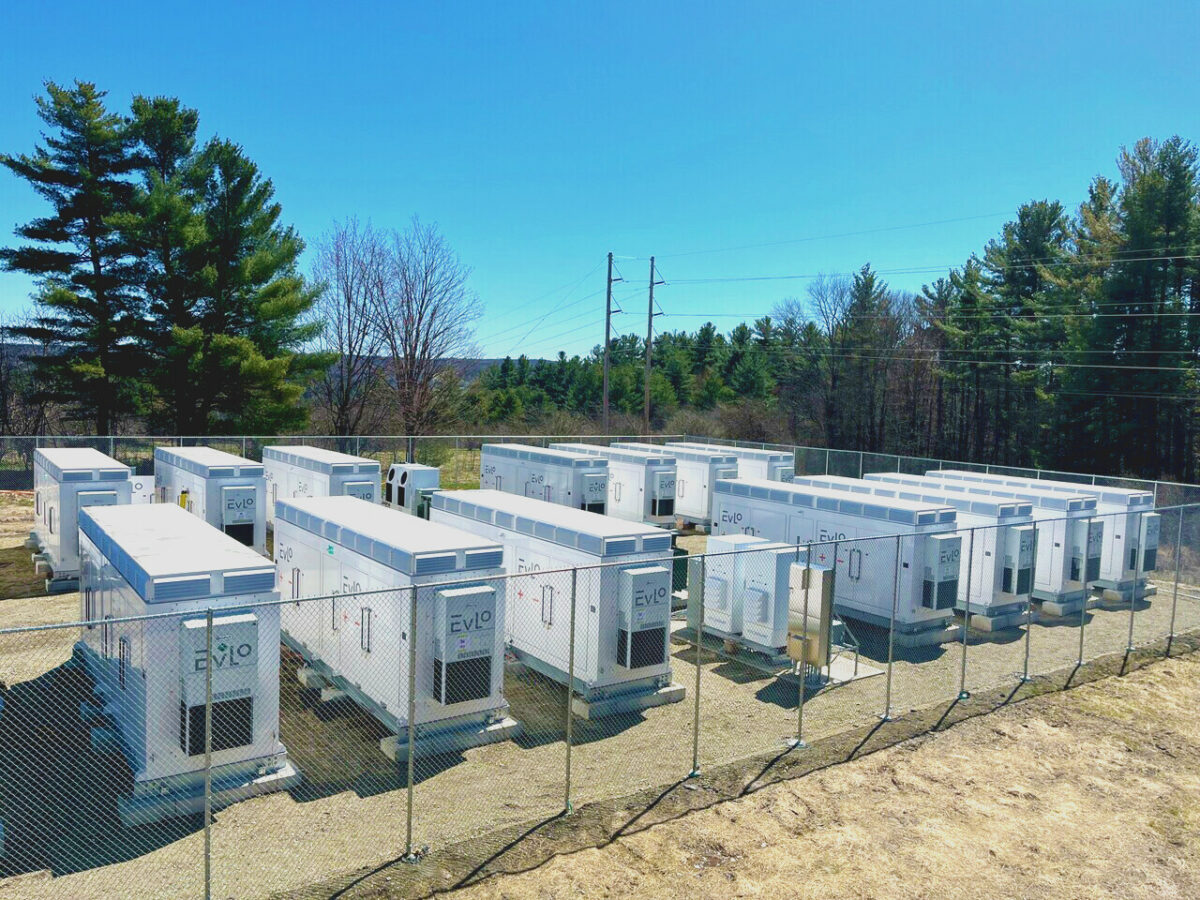EVLO puts into operation first battery energy project in the US in Troy, Vermont


EVLO Energy Storage Completes First Utility-Scale BESS Project in the US

Located in Troy, Vermont, the project will help increase the amount of clean energy generation available to the New England grid and reduce peak demand. EVLO photo.
Introduction
EVLO Energy Storage Inc, a fully integrated battery energy storage system (BESS) provider and wholly owned subsidiary of Hydro-Québec, has successfully commissioned its first utility-scale BESS project in the United States. The project, located in Troy, Vermont, aims to contribute to the Sustainable Development Goals (SDGs) by increasing clean energy generation and reducing peak demand.
Project Details
The contracted 3 MW/12 MWh installation in Troy, Vermont, will store energy during periods of strong energy production for later use during peak energy demand. This will help address the intermittency of renewable power generation and provide value to local utility customers. The project consists of 16 EVLO 1000 units and four Power Conversion System (PCS) platforms, all managed by the EVLOGIX Energy Management System (EMS).
Contribution to SDGs
The Troy project will not only provide clean energy to the New England grid but also contribute to the achievement of the SDGs. By demonstrating how battery storage can enable the expansion of renewable energy production and further integrate renewables into the grid, the project will support SDG 7 (Affordable and Clean Energy) and SDG 13 (Climate Action).
Partnerships and Long-Term Service Agreement
EVLO will monitor and maintain the BESS under a 20-year long-term service agreement, in partnership with Vermont utilities including the Vermont Electric Cooperative. The collaboration with pioneering utilities in Vermont showcases the importance of collective action to accelerate the energy transition and achieve SDG 17 (Partnerships for the Goals).
Expansion and Future Projects
This project marks EVLO’s first BESS project in the US, highlighting the increasing significance of battery storage in the energy sector. It also signifies the company’s expanding reach beyond Canada and Europe. EVLO currently has several other projects in development in the US, demonstrating its commitment to building a cleaner and more resilient energy future.
Quotes
“EVLO is proud to work with pioneering utilities, such as the ones in Vermont, that take action to accelerate the energy transition,” said Sonia St-Arnaud, president and CEO at EVLO. “To effectively increase renewable energy utilization, a robust battery energy storage sector is critical, and we’re proud to share EVLO’s power grid and BESS know-how to this important project, the first of many we currently have in development in the US.”
“Our hope is this project will help demonstrate the critical role that battery energy storage can have, empowering us to deliver more reliable and sustainable power to the communities we serve,” said Rebecca Towne, CEO of Vermont Electric Cooperative. “As more renewable capacity comes online, this project is a great example of helping the regional grid through collaboration and innovation.”
About EVLO Energy Storage Inc.
EVLO Energy Storage Inc. (EVLO) is a fully integrated battery energy storage systems and solutions provider and subsidiary of Hydro-Québec. EVLO’s utility-scale battery energy storage systems and controls software deliver superior safety and reliability backed by decades of R&D. Its comprehensive services are led by a veteran team of industry experts passionate about partnering with customers to build a cleaner, more resilient energy future.
Source: August 20, 2024 – Montréal — EVLO Energy Storage Inc
Subscribe to Vermont Business Magazine
To support great journalism, access our archives, and get unique features like our award-winning profiles, Book of Lists & Business-to-Business Directory, subscribe HERE!
SDGs, Targets, and Indicators
-
SDG 7: Affordable and Clean Energy
- Target 7.2: Increase substantially the share of renewable energy in the global energy mix
- Indicator 7.2.1: Renewable energy share in the total final energy consumption
-
SDG 9: Industry, Innovation, and Infrastructure
- Target 9.4: Upgrade infrastructure and retrofit industries to make them sustainable
- Indicator 9.4.1: CO2 emission per unit of value added in manufacturing industries and construction
-
SDG 13: Climate Action
- Target 13.2: Integrate climate change measures into national policies, strategies, and planning
- Indicator 13.2.1: Number of countries that have integrated mitigation, adaptation, impact reduction, and early warning into primary, secondary, and tertiary curricula
Analysis
1. Which SDGs are addressed or connected to the issues highlighted in the article?
The issues highlighted in the article are connected to SDG 7 (Affordable and Clean Energy), SDG 9 (Industry, Innovation, and Infrastructure), and SDG 13 (Climate Action).
2. What specific targets under those SDGs can be identified based on the article’s content?
Based on the article’s content, the specific targets identified are:
- Target 7.2: Increase substantially the share of renewable energy in the global energy mix
- Target 9.4: Upgrade infrastructure and retrofit industries to make them sustainable
- Target 13.2: Integrate climate change measures into national policies, strategies, and planning
3. Are there any indicators mentioned or implied in the article that can be used to measure progress towards the identified targets?
The article mentions or implies the following indicators:
- Indicator 7.2.1: Renewable energy share in the total final energy consumption
- Indicator 9.4.1: CO2 emission per unit of value added in manufacturing industries and construction
- Indicator 13.2.1: Number of countries that have integrated mitigation, adaptation, impact reduction, and early warning into primary, secondary, and tertiary curricula
Table: SDGs, Targets, and Indicators
| SDGs | Targets | Indicators |
|---|---|---|
| SDG 7: Affordable and Clean Energy | Target 7.2: Increase substantially the share of renewable energy in the global energy mix | Indicator 7.2.1: Renewable energy share in the total final energy consumption |
| SDG 9: Industry, Innovation, and Infrastructure | Target 9.4: Upgrade infrastructure and retrofit industries to make them sustainable | Indicator 9.4.1: CO2 emission per unit of value added in manufacturing industries and construction |
| SDG 13: Climate Action | Target 13.2: Integrate climate change measures into national policies, strategies, and planning | Indicator 13.2.1: Number of countries that have integrated mitigation, adaptation, impact reduction, and early warning into primary, secondary, and tertiary curricula |
Source: vermontbiz.com









